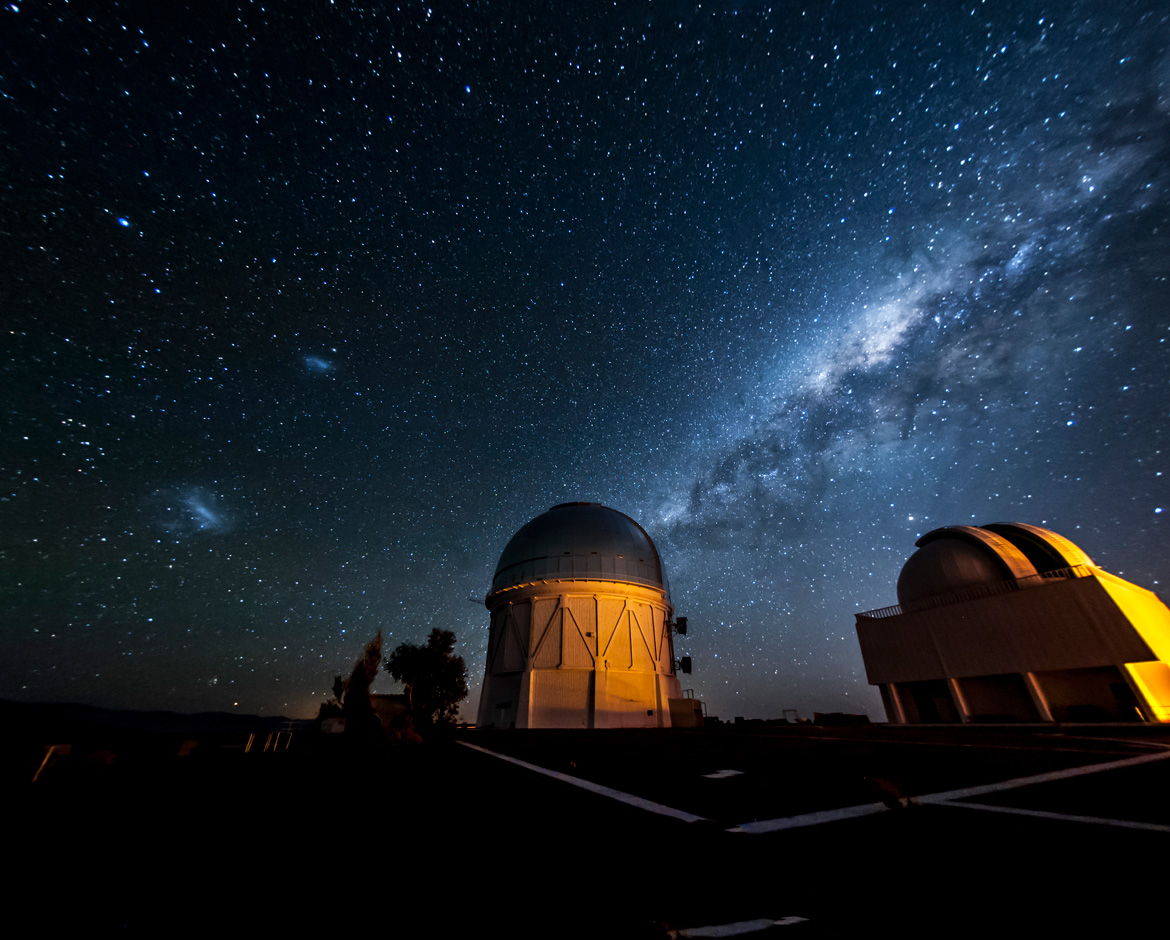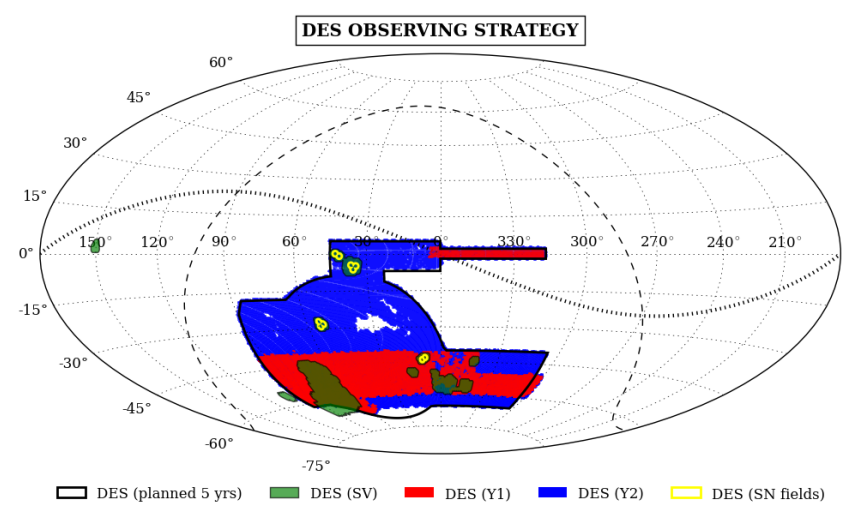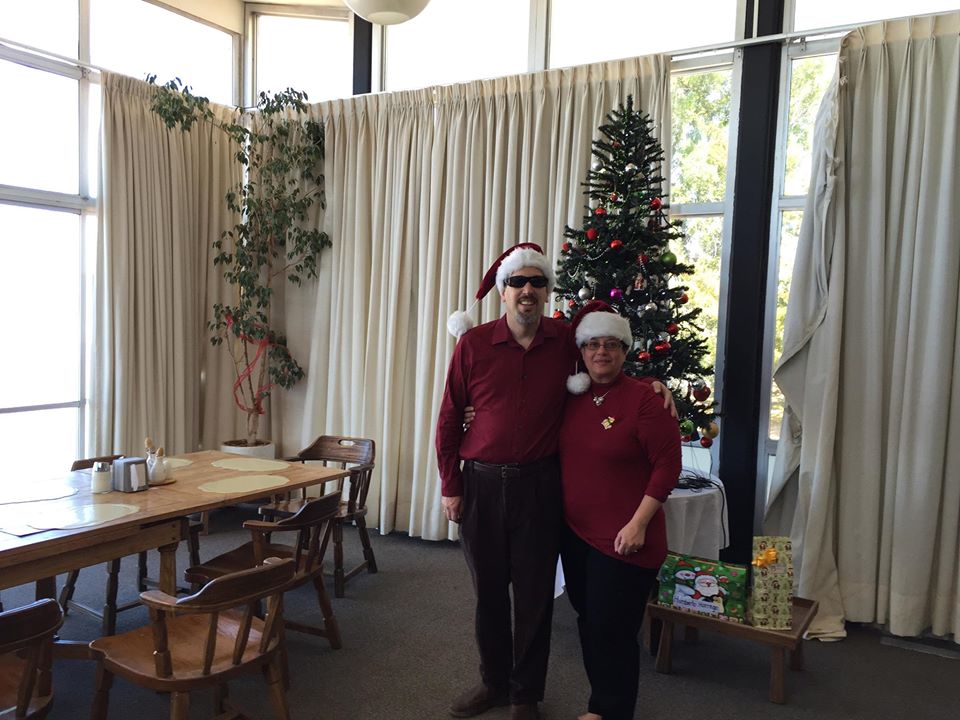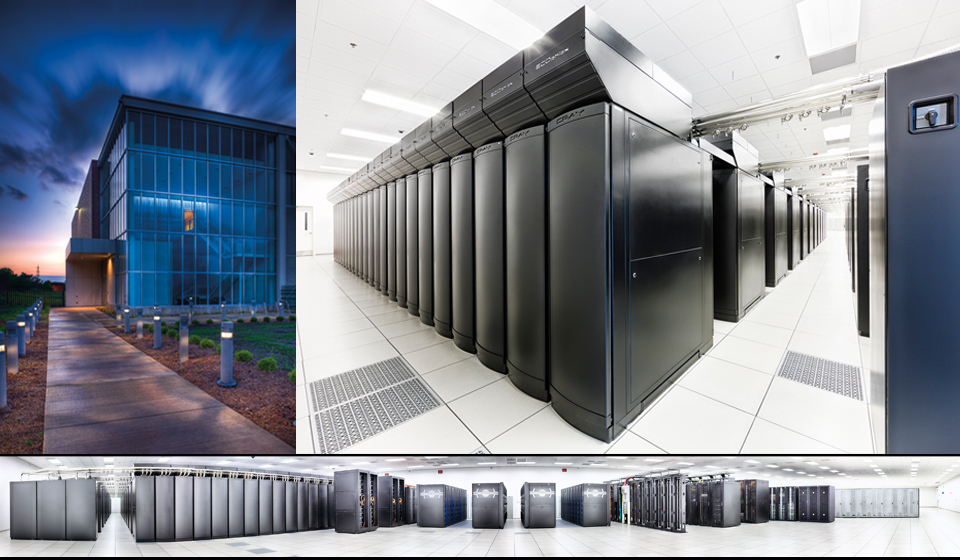DES surveyed a 5000 square degree area of the southern sky (roughly 1/8 of the total sky) over 525 nights using the Dark Energy Camera (DECam) mounted on the Blanco 4-meter telescope at the Cerro Tololo Inter-American Observatory, perched high in the Chilean Andes. It is recorded information on over 300 million galaxies, most so faint that their light is around 1 million times fainter than the dimmest star that can be seen with the naked eye. DES also discovered and measured the brightness of thousands of supernovae by repeatedly targeting ten regions of the sky every six nights.
Survey Strategy

Figure 1: Blanco Telescope Dome and Milky Way. Photo Credit: Reidar Hahn, Fermilab
DES comprises two surveys: a wide-area survey and a time-domain survey.
The wide-area survey covers a large, contiguous area of sky (5000 square degrees), each part of which is observed ten times in each filter over the course of the survey; the long cumulative exposure time is needed to detect very faint galaxies, and the wide survey area enables us to detect a very large number of them. The time-domain survey covers a smaller area on the sky (27 square degrees), but exposures are repeated a large number of times at regular, six-night intervals over the course of the survey.
The Wide-Area Survey Footprint
Not all parts of the sky are equally useful for dark energy measurements: the choice of which area of sky to survey must be made carefully, so that the telescope time can be used efficiently.
We live within the Milky Way galaxy, a disk-like distribution of billions of stars that is visible as a band of faint light across the sky on a dark night far from city lights. The stars and dust within the Milky Way disk obscure the distant galaxies we wish to measure, so the survey is designed to look at galaxies away from the plane of our galaxy. We also need to focus on a region of sky that is overhead at night in Chile, where the telescope is sited. Figure 2 shows the footprint of the wide-area survey on the sky (colored region) in celestial coordinates; the dashed curve shows the approximate location of the Milky Way disk in these coordinates, indicating that the survey area is away from the plane of our galaxy.

Figure 2: DES Observing Footprint. Image Credit: Lahav et al., 2016
We also designed the survey to cover areas of sky that have been observed by complementary experiments. For example, the South Pole Telescope (SPT) has mapped the cosmic microwave background radiation over a 2500 square degree region of the sky, nearly coincident with the red colored region in the lower portion of the adjacent sky map. Combining the DES and SPT data provides a powerful way to probe clusters of galaxies, one of the four methods we are using to probe dark energy. We can also compare the large-scale DES and SPT maps to constrain the formation of structure, which also yields important clues to dark energy. The gun-barrel shaped region of the survey (blue and red) that lies along the celestial equator is another sky area that has been observed by other telescopes, both in optical light and at other wavelengths. That region of sky, which passes directly overhead of someone standing on the earth’s equator, is visible from both the northern and southern hemisphere, while the more southerly portion of the footprint is only visible from the southern hemisphere.
These different design requirements result in the irregular shape of the DES footprint shown here: the rectangular regions along the celestial equator, the extended quasi-rectangular region at the far south that overlaps SPT observations, and the round intermediate region that connects those two and fills out the survey area.
Observing

Figure 3: DES observers (Douglas Tucker and Sahar Allam) at the Cerro Tololo Inter-American Observatory Dining Room
Observing for DES takes place from August through February each year, when the survey footprint is overhead at night. Although a computer algorithm (ObsTac, described below) makes the decision of where the telescope will point next, members of the DES collaboration work in the telescope control room each night during the survey to start and end each night’s observing sequence, monitor the systems and the quality of the data coming out of the camera, and track progress.
Our observers stay in dormitories on the mountain, a short walk downhill from the telescope, sleeping during the day and using the telescope and camera at night. Each observer typically stays for about a week. Each night two to three DES members work at the telescope console to monitor operations, one monitoring camera operations, another monitoring the data, plus a run manager who oversees the observers’ activities and communicates with the DES Operations team each afternoon.
Observing Tactician (ObsTac)
While observing, many factors influence which exposure should be taken at a given time. Different exposures can be taken under different conditions, and at different times in the night or times of year. For example, when the moon is up, we observe in the red filters, since moonlight is blue. Also, areas of the sky that have been completed should not be observed again, while areas of the sky which have not been previously observed, or were observed under poor conditions, need to be re-observed. In addition, we want to observe regions when they are closest to being overhead, so that the light passes through the minimum amount of Earth’s atmosphere on its way to the telescope–this results in the best-quality images.
When observing the wide-area footprint, DES takes a new image roughly every two minutes: the exposures are typically 90 seconds long, with another 30 seconds for readout of the camera and slewing of the telescope to its next pointing. To avoid wasting time, the time between exposures must be kept to a minimum, and it is not practical for human observers to perform all of the bookkeeping and conditions necessary over the course of each night: efficient operations requires automation of the selection and execution of science observations during the night.
The Observing Tactician software, ObsTac, automates exposure selection, taking into account the many factors that influence the choice of exposure: the time and date, the weather conditions, the phase and location of the moon, and records of what has been completed and what remains to be completed. ObsTac instructs the telescope where to point and the camera how long to expose and through which filter. It also decides when to observe the wide-area survey and when to take supernova exposures in the time-domain survey: the supernova survey can be done under poorer atmospheric conditions than most of the wide-area survey, and it must be done on a roughly weekly cadence that enables discovery and measurement of supernovae.
Data Management

Figura 4: The Blue Waters supercomputer at NCSA.
What happens to an image of the sky after it’s taken by the Dark Energy Camera? This is where the Dark Energy Survey Data Management (DESDM) system comes in, providing the infrastructure and computational power needed to store the data and process it into useful images and catalogs that can be analyzed by scientists. Images are sent from the observatory over the internet via the National Optical Astronomy Observatory (NOAO) Data Transport System to the National Center for Supercomputing Applications (NCSA) at the University of Illinois in Urbana-Champaign, IL (UIUC). Once there, the DESDM system “processes” each image, removing artifacts due to the camera, subtracting signatures from the night sky, and producing a “reduced” or cleaned image. These images are analyzed to determine if they meet the data quality requirements of the survey; the ones that do will be used for further analysis, those that don’t will be re-observed. The supernova images are also processed rapidly in order to identify new supernovae that can be followed up with other telescopes. The DESDM team provides all the infrastructure to process, manage, and store the images and scientific data and serve them to the collaboration. DESDM comprises astronomers, computer scientists, and system engineers who work together at the intersection of scientific research and the computing systems that enable it.
Each DECam image is a gigabyte in size. The Dark Energy Survey takes a few hundred of these extremely large images per night, producing as much as 2.5 terabytes of data per night. This presents a very high data-collection rate for an astronomy experiment. DESDM processes the images on large computing clusters at NCSA and at Fermilab, and the images from a night are generally processed by the next day. That means each night DESDM processes enough data to fill about 4 laptop computers!
DES takes images about half of the year. During the other half of the year, we update and make improvements to the DESDM system. This involves improving scientific algorithms (how scientific values are measured), fixing any bugs in the codes, upgrading the computing and storage infrastructure, running numerous tests, and validating image and science quality.
Once these tests have passed all operational and scientific requirements, the DESDM team reprocesses all the images taken by the DES. This reprocessing not only cleans the images and catalogs the stars and galaxies, but also “stacks” or co-adds the images. “Stacking” is the process of overlaying images of the same part of the sky, producing deeper, high-quality images for scientific analysis. DESDM then releases these clean, stacked, and science-ready images to the DES collaboration so that scientists can make great discoveries with the data!
Data taken with DECam by astronomers during non-DES observing are processed through the DECam Community Pipeline at NOAO, which was produced by the DESDM team, and made available for analysis.